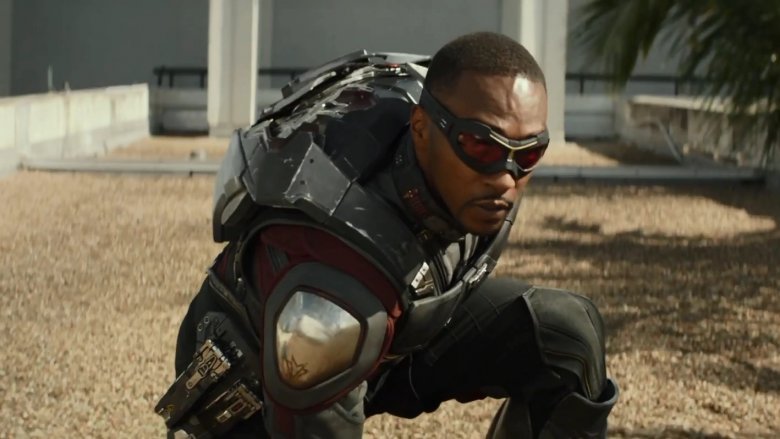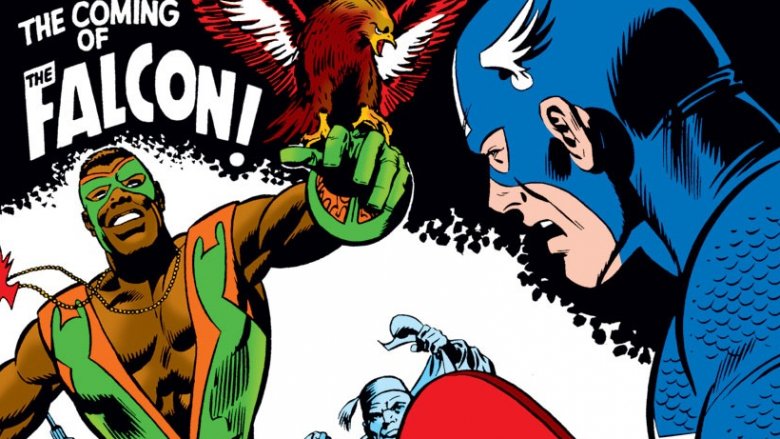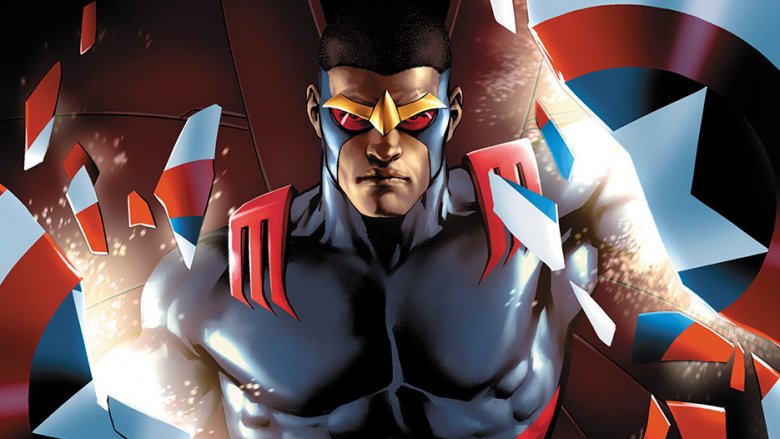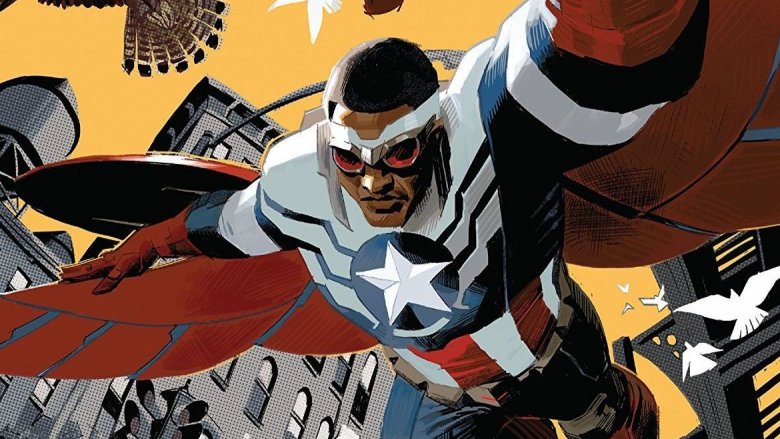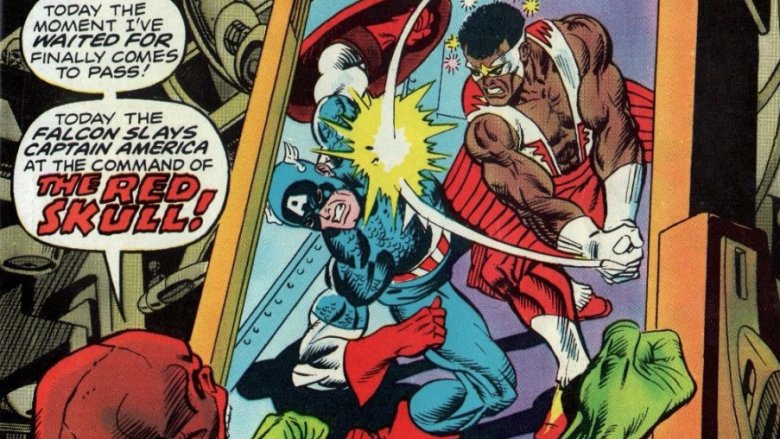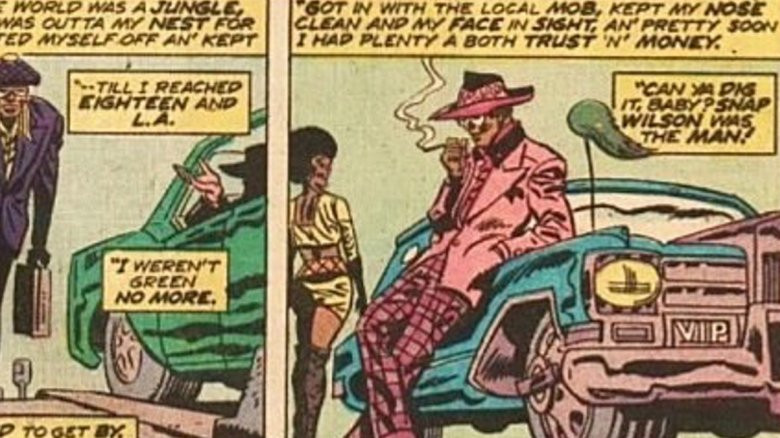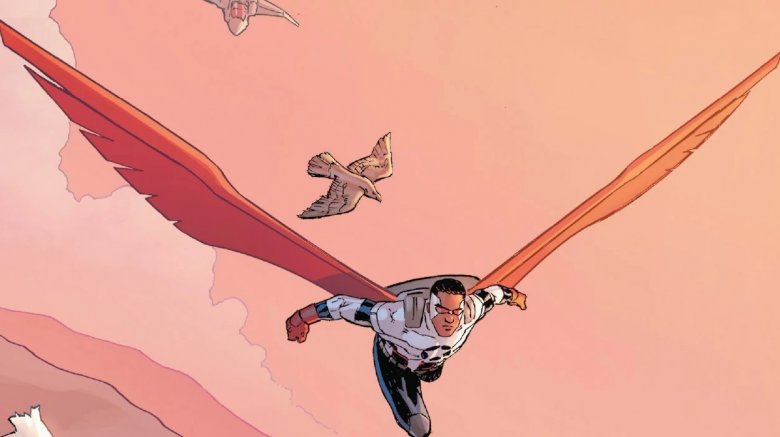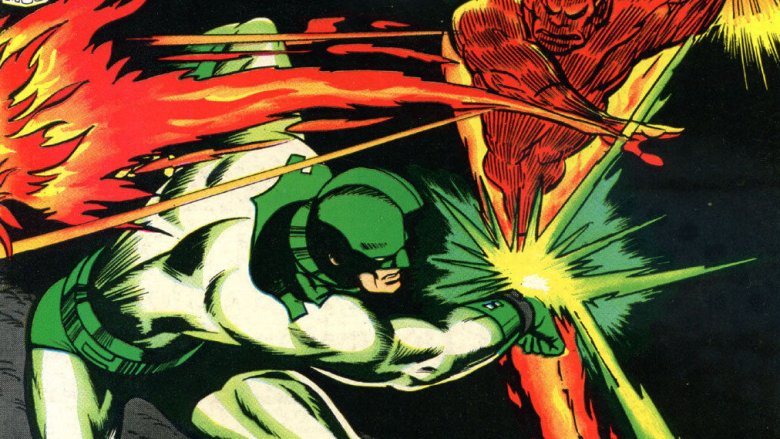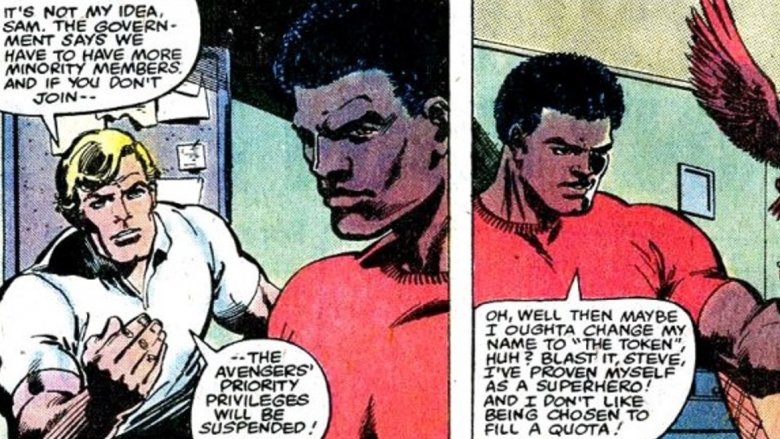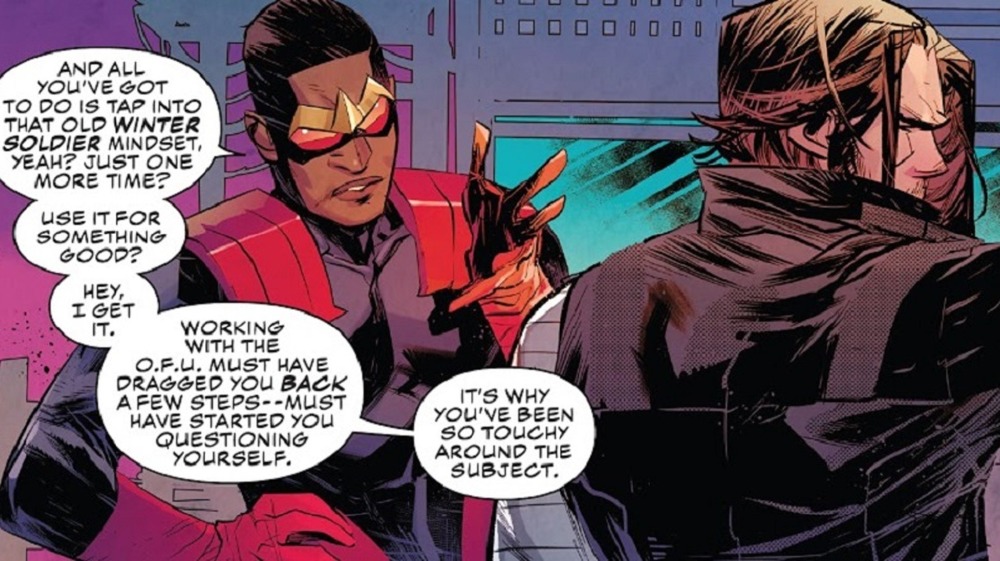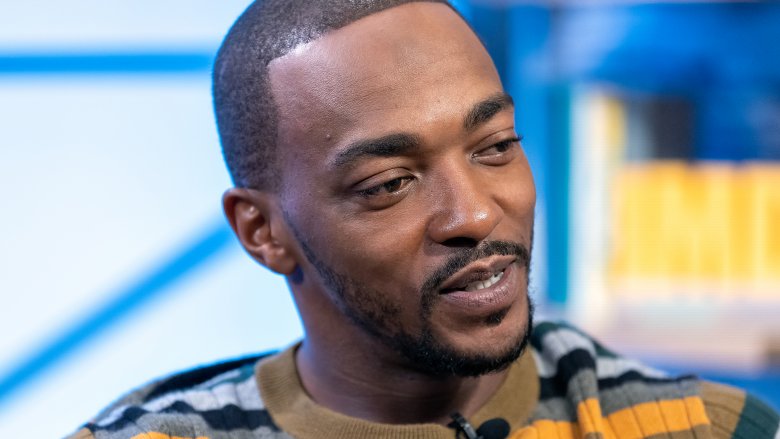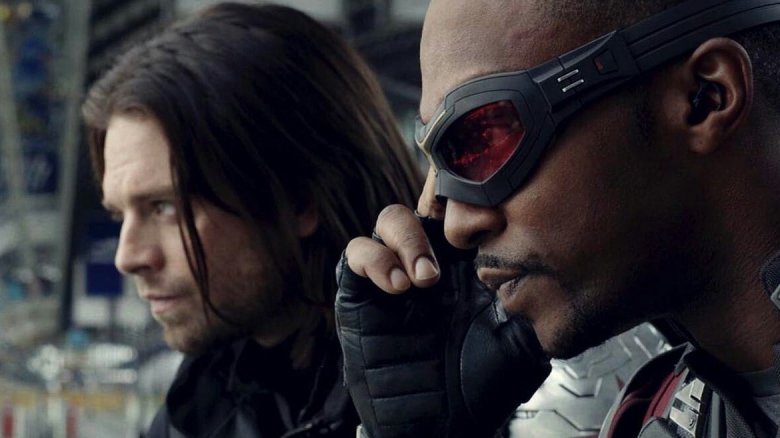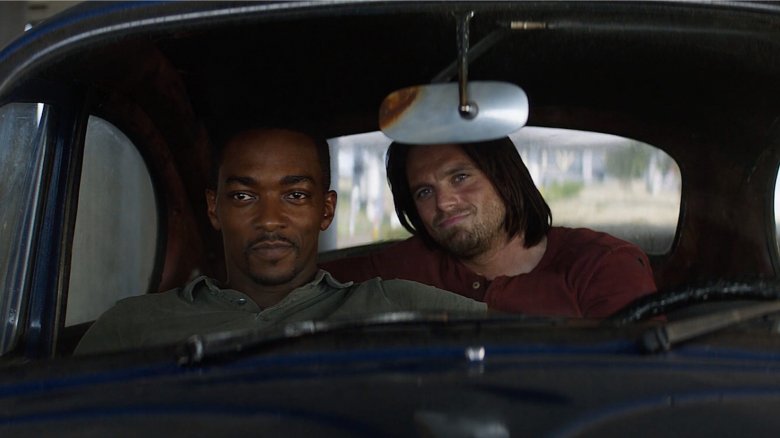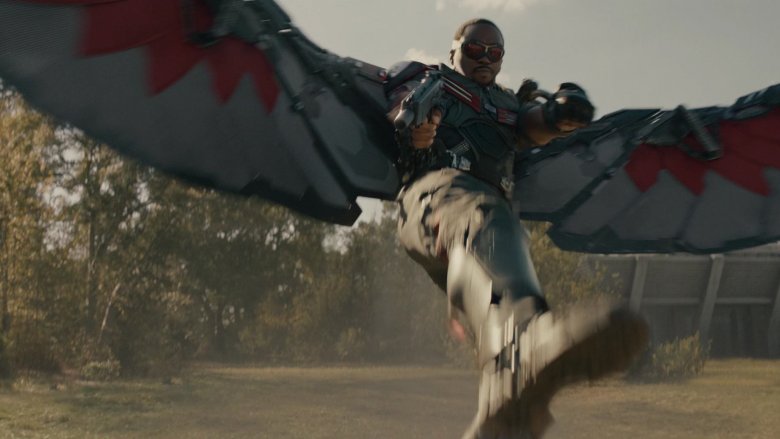The Untold Truth Of The Falcon
Spoilers for Avengers: Endgame and all previous entries in the Marvel Cinematic Universe are up ahead!
Comic book characters were once nearly inaccessible to mainstream pop culture; the convoluted backstories and gatekeeping medium of comics made it difficult for all but the most popular heroes to gain any notoriety. As entertainment becomes increasingly dominated by comic heroes, however, even less widely known characters are starting to come out of the woodwork and gain some mainstream attention. One such character is Sam Wilson, a.k.a. Falcon, played by Anthony Mackie in the MCU.
Not only is Falcon getting his own TV show alongside Winter Soldier on Disney+, but he also took up Captain America's shield during the final moments of Avengers: Endgame and looks like he'll be the new Cap in some form or another going forward in the MCU. This moment has precedent in the comics (more on that in a bit), and Falcon has had a fascinating history since his creation in 1969.
In preparation for his new show and seemingly expanded role in the next wave of Marvel films, we're taking a look today at some of the more interesting aspects of this fan favorite character's history. This is the untold truth of the Falcon.
The coming of the Falcon
The Falcon first debuted in Captain America #117, which was published in 1969. Sam Wilson was a resident of Harlem, who discovered a group of Nazis led by Red Skull operating on a tropical island called Exile. Wilson and his trained falcon, Redwing, soon discovered the group's nefarious plan. He learned they were enslaving indigenous tribes on the island, and he was trained and encouraged by Captain America to adopt a superhero moniker and help the tribes.
Artist Gene Colan had the idea for the Falcon partly as a response to the civil rights movement, and he stands out as an empowering character. For one, he's arguably the first mainstream black hero to not have the word "Black" in his name. Falcon was also considered an equal to Captain America, rather than a sidekick. The two received co-billing in the ongoing Captain America and the Falcon series, which ran for almost one hundred issues in its original run and has been restarted a few times over subsequent decades.
Solo flight
Despite receiving co-billing with Cap and being viewed largely as his equal, it took a long time for Falcon to get a chance to shine in his own series. His origin story has been retconned several times, and he — like many other comic book characters — has bounced around to several different teams. He has been a part of both the Defenders and the Avengers, but he has almost always been closely tied to Captain America.
Falcon appeared as a solo act in an issue of Marvel Premiere, a "tryout" series that the company used to gauge interest in new material. However, it was apparently never intended to begin a Falcon solo series. He also led a four-issue miniseries in 1983 that identified Sam Wilson as a mutant — a plot twist that was wisely retconned in 2001.
It wasn't until 2017, almost 50 years after the character's debut, that Falcon got his own true solo series — the sensibly titled The Falcon, led by writer Rodney Barnes and artist Joshua Cassara. Of course, as longtime readers know, Falcon's alter ego, Sam Wilson, had the opportunity to lead his own series before that — and as a much more well-known character.
The Falcon and the Shield
Sam Wilson actually replaced his original partner, Steve Rogers, as Captain America for a few years starting in 2014. The transition came after Rogers had the Super-Soldier Serum drained from his body during a battle with Iron Nail, which forced him to hang up the shield as he rapidly aged into an old man. Considering how long the two fought side by side, Wilson was a natural fit to take over the role and continue Captain America's legacy.
This makes the ending of Avengers: Endgame even more significant to longtime fans of the comics — since both Bucky Barnes and Sam Wilson have taken up the shield in the comics, it really could have been either that filled the shoes of Steve Rogers after he returned from his time-traveling adventure as a much older man. Rogers and Wilson are similarly heroic, but it will be interesting to see how the completely different backstory of Wilson meshes with the role of Captain America in the MCU.
Redwing
In the MCU, Falcon has some technological upgrades that fit with the more modern interpretations of the character. In his original iterations, however, he was pretty much just a dude in a costume. As his character started to gain a bit more traction, certain elements were added: for example, miniature solar arrays were inlaid into the fiber, which allowed his suit to essentially provide its own power.
In the movies (and later iterations of the comic), Falcon also pilots a Stark Industries drone, codenamed "Redwing." That's a far cry from his early years, when he was partners with an actual trained falcon named Redwing. Falcon's origin involved him forging a connection with Redwing, who's been with the character ever since he debuted, and the two share an emotional bond (and an even stronger one — more on that shortly) that helps them battle foes together. Redwing even stayed by Falcon's side when he took up Captain America's shield.
Totally Cube-ular
Falcon's origin story has been changed a few different times, but one thing has remained constant: he was originally a relatively ordinary man with no superpowers to speak of. In his debut story, he battled the Red Skull alongside his falcon, Redwing, and the connection between Wilson and his avian ally seemed abnormally strong. We eventually learned that Red Skull himself helped gift this power to Wilson, part of a plot that involved a familiar Marvel MacGuffin — the Cosmic Cube.
Red Skull used the Cosmic Cube to brainwash Wilson into battling with Captain America, and also to forge a telepathic link between Wilson and Redwing. As he grew into his role as Falcon, Wilson learned to expand this link — it began as an ability to communicate, but he soon started to be able to see through Redwing's eyes. Eventually that expanded to the ability to see through any bird's eyes, and even access their memories.
Falcon's encounter with the Cosmic Cube had other side effects as well, including retconning his origin story on more than one occasion.
Retconning is a Snap
The nature of comic books can give many characters confusing back stories — since so many different writers play a role in telling tales and every comic is loosely connected inside a larger universe, some pretty strange details can emerge when you go back far enough. Despite Falcon having a strong debut, his character was later given a new and disappointingly stereotypical origin before long — one Marvel fortunately had the hindsight to eventually go back and retcon.
In his original story, Falcon was a Harlem social worker, making his partnering with Captain America a pretty logical leap. That was overturned in a later run — Sam Wilson was actually "Snap" Wilson, a Harlem mobster and pimp who was essentially the epitome of an ugly racial stereotype. His social worker origin was actually a false memory, a side effect of Red Skull using the Cosmic Cube against him.
Fast forward a few decades to 2015, and it turns out that the "Snap" Wilson memory was actually the false memory, implanted by Red Skull to sow confusion in the ranks. Wilson's life as a social worker? That was the real memory, overtaken by the power of the Cosmic Cube. Took a while, but we should be good for at least another few decades, when Marvel will undoubtedly Cosmic Cube him again.
The Black Panther connection
Falcon has gone through some significant technological upgrades over the years. His first modern costume was created at Captain America's request not long after he first appeared, and was made by a familiar face: T'Challa himself, the Black Panther.
Originally, Black Panther designed Falcon's wings to have only a few fancy implements — the aforementioned solar receptors that help power everything, plus jet boosters and a few other trinkets. Over time, Falcon has had T'Challa (among others) add upgrades that give his suit versatility and power to rival even some of the slickest heroes this side of Iron Man.
One more recent costume iteration features holographic wings made of "hard light," which feature a maximum wingspan of fifty feet. The wings can shield him from enemy firepower, they're virtually indestructible, and they can be manipulated into a variety of shapes and configurations instantly. All of this is controlled through a cybernetic connection run through Falcon's mask directly into his brain — the whole system is controlled at a mere thought. Quite a leap from "guy wearing fabric wings."
The Captain Marvel connection
A huge facet of comic book characters becoming more than random one-shots is the initial impression they make, and a huge part of that comes from their look. There's a reason Falcon regularly teamed with Captain America and even stepped into the role for a time, while a character like Codpiece was relegated to a single issue of Doom Patrol. Yes, Codpiece has a groin cannon.
Stan Lee — surprise — is a credited co-creator of the Falcon, but the artist who brought him to life is Gene Colan, who has a pretty impressive resume of lasting Marvel characters: Colan helped create many characters that are major players in Marvel's modern takeover of pop culture. He created Carol Danvers and Mar-Vell, who showed up in the MCU to be played by Brie Larson and Jude Law. Colan created Blade and Deacon Frost, who were played by Wesley Snipes and Stephen Dorff in the pre-MCU Blade. Further Colan creations include Whiplash (Mickey Rourke in Iron Man 2), Ben Urich (Vondie Curtis-Hall in Netflix's Daredevil), and many others.
Colan also illustrated the amazing Marvel series The Tomb of Dracula in the 1970s — which is where Blade made his first appearance. During his distinguished career, Colan won two Eagle Awards and an Eisner Award before passing away in 2011.
A hero on his own terms
Comics love to critique, satirize, and subvert things that are happening in the real world, and Falcon has tackled his fair share of racial issues. One of the oddest times he did so came during a brief Avengers run that began in 1979, when Wilson joined the team and quit almost immediately.
At this point in time, the United Nations liaison for the Avengers was a man named Henry Gyrich. He tasked Captain America with recruiting Falcon to join the team. However, Falcon learned that Gyrich had merely tapped him to fill a racial hiring quota, and he wasn't pleased. Falcon has come and gone from a variety of teams throughout his years in the Marvel Universe, but he has almost always stayed true to his convictions. As a character, he believes in being recognized for a person's skills and abilities, and his principle in quitting a group like the Avengers due to being a "token" hire helps epitomize that. Here's betting that whatever the future might hold for him in the studio's next phase, Sam Wilson will do the name "Captain America" proud in the MCU.
Teaming up with Bucky Barnes
Sam Wilson is, in many ways, the person who allowed Steve Rogers to heal from grieving Bucky Barnes when they became partners. When it was revealed that Bucky had been alive all along but brainwashed into becoming a Soviet assassin, Sam was there for Steve and tried to help Bucky regain his memories. Their dynamic in the MCU is a little different than in the comics, as Sam became a good friend to Captain America but they didn't have decades of history working together. In the comics, a mutual respect (with some antagonism) between Sam and Bucky was earned not just because of their relationship with Cap, but because they both spent time carrying the shield when Steve Rogers stepped aside.
However, there haven't been many comics that explored this relationship — that is, until the 2020 Falcon & Winter Soldier series. It's ideally suited for a TV adaptation, as it focuses on Sam's status working with veterans as a social worker and Bucky's status as an assassin trying to find a new way to do things. When the series picks up, Bucky has received a pardon for his murderous past for defeating the HYDRA Captain America, but it's contingent on working for an agency that located and eliminated domestic terrorists.
The series forces Sam and Bucky together as they try to track down Baron Zemo as well as another mysterious figure who's trying to take over HYDRA and the Natural, a psychotic teenage assassin with a Captain America fetish. The series deepens their friendship and allows both to evolve — much like their Disney Plus series is poised to do.
Who is involved in Falcon's upcoming Disney+ show?
We know very little about the Disney+ Falcon and Winter Soldier series so far, as Marvel and Disney have been very tight-lipped about what to expect. However, we do know a bit about the casting as well as who will be writing the show.
Most importantly, both Anthony Mackie and Sebastian Stan will be continuing their respective roles of Sam Wilson and Bucky Barnes, joined by returning MCU stars Emily VanCamp (who plays Sharon Carter) and Daniel Brühl (who plays the nefarious Baron Zemo). With Wilson receiving Captain America's shield at the end of Avengers: Endgame, it also seems likely that the show will focus on Wilson's transition from Falcon to becoming the new Captain America. Variety reports that Malcolm Spellman, who is best known for writing several episodes of the TV series Empire, has been tapped as a writer and executive producer for Falcon and Winter Soldier. It was the first of several planned MCU limited series to publicly land a writer.
What are Marvel's plans for their Disney+ shows?
Marvel and Disney have big plans for their streaming network. Multiple MCU-related shows are coming to Disney+, and all are tied directly into characters and plotlines we already know from the Marvel Cinematic Universe. Each series is expected to be tied to characters who have not starred in their own standalone film — don't expect a Thor series on Disney+.
Besides Falcon and Winter Soldier, there's WandaVision, which premiered in early 2021, as well as shows based around Loki, She-Hulk, and Hawkeye. Per Variety, these are all expected to be limited series, running for six to eight episodes total, rather than multi-season shows. Falcon and Winter Soldier was originally expected to be the first MCU series to launch on Disney+, but COVID-related production delays pushed its premiere back behind WandaVision, to March 19, 2021. Loki, meanwhile, will follow in May. Theaters may be largely shuttered, but Marvel fans still have new adventures to look forward to throughout 2021.
Plenty of stories to choose from
We know very little about what the plot of Falcon and Winter Soldier will be, but it isn't too hard to speculate. There are a few runs from the comics that seem like very likely contenders, especially considering where the characters left off after Avengers: Endgame.
The most likely route for the show to take would involve borrowing beats from the Sam Wilson: Captain America run. In 2015, Captain America fought a battle with the Iron Nail. Even though he eventually proved victorious, the Super Soldier Serum was drained from his body, causing Steve Rogers to age rapidly. He passed the mantle to Sam Wilson, who had to cope with the responsibilities of becoming Captain America, rather than just fighting alongside him. Considering the similar circumstances at the conclusion of Endgame, this storyline seems a likely influence on the series.
As far as antagonists are concerned, thanks to pre-release leaks like the Falcon & Winter Soldier Super Bowl trailer, we can be confident that the show's chief antagonist will be a returning Helmut Zemo, and our heroes will also have to contend with Marvel villains Ultimatum and Flag-Smasher. No rest for Marvel heroes, right?
Digging deep
Obvious contenders aside, there's no shortage of comics storylines that could at least contribute elements to the story of Falcon and Winter Soldier, even if the show doesn't directly translate the source material. Due to the conclusion of Avengers: Endgame, it seems unlikely we will see a direct retelling of the story of when Bucky Barnes became Captain America. However, the MCU has rarely done straight adaptations of comic book storylines, so we could definitely see some elements from when Bucky took up the shield in the comics. He seemed like he wasn't terribly disappointed that Cap chose Wilson as his successor, but there are several elements from Bucky's run in the comics that could translate well to the series.
Depending on the direction Marvel wants to take the character, Falcon and Winter Soldier could also adapt elements from the stories when Falcon originally joined the Avengers in the comics. For now, we'll just have to keep waiting for Falcon and Winter Soldier to take flight.
